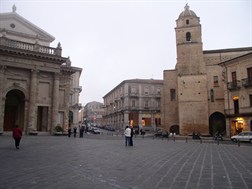Lanciano
 The origins of the ancient Anxanum are very remote and date back to the twelfth century B.C. In the Middle Ages, the Emperor Frederick II of Swabia (1194-1250) gave the town its status, which was then confirmed and made perpetual by the King of Naples Manfred of Sicily (1232-1266), making of it crown land, governed directly by the king and not subjected to any feudal lord. The economic well-being and the importance of this political and commercial centre in the Middle Ages were also confirmed by the institution of the Diocese (later Archdiocese) of Lanciano, distinct from that of Chieti, in 1515. In the Early Modern age, however, Lanciano gradually lost wealth and power, directly involved, as the whole of Abruzzo, first in the war for control of Italy between the Emperor Charles V and King Francis I of France, then in the repeated actions of pirates and brigands from the inland. Lanciano’s autonomy was interrupted in 1640, when the Viceroy Medina de las Torres sold the now former state town to the Duke of Castro Pallavicini. A few years later, and for more than a century, the D’Avalos, marquises of Vasto and Pescara, governed the city. (photo: Piazza del Plebiscito, Lanciano).
The origins of the ancient Anxanum are very remote and date back to the twelfth century B.C. In the Middle Ages, the Emperor Frederick II of Swabia (1194-1250) gave the town its status, which was then confirmed and made perpetual by the King of Naples Manfred of Sicily (1232-1266), making of it crown land, governed directly by the king and not subjected to any feudal lord. The economic well-being and the importance of this political and commercial centre in the Middle Ages were also confirmed by the institution of the Diocese (later Archdiocese) of Lanciano, distinct from that of Chieti, in 1515. In the Early Modern age, however, Lanciano gradually lost wealth and power, directly involved, as the whole of Abruzzo, first in the war for control of Italy between the Emperor Charles V and King Francis I of France, then in the repeated actions of pirates and brigands from the inland. Lanciano’s autonomy was interrupted in 1640, when the Viceroy Medina de las Torres sold the now former state town to the Duke of Castro Pallavicini. A few years later, and for more than a century, the D’Avalos, marquises of Vasto and Pescara, governed the city. (photo: Piazza del Plebiscito, Lanciano).
